Celebrating the players who defined the decade, both with impressive peaks and extended longevity.
July 15, 2020 by Patrick Stegemoeller in Opinion with 0 comments
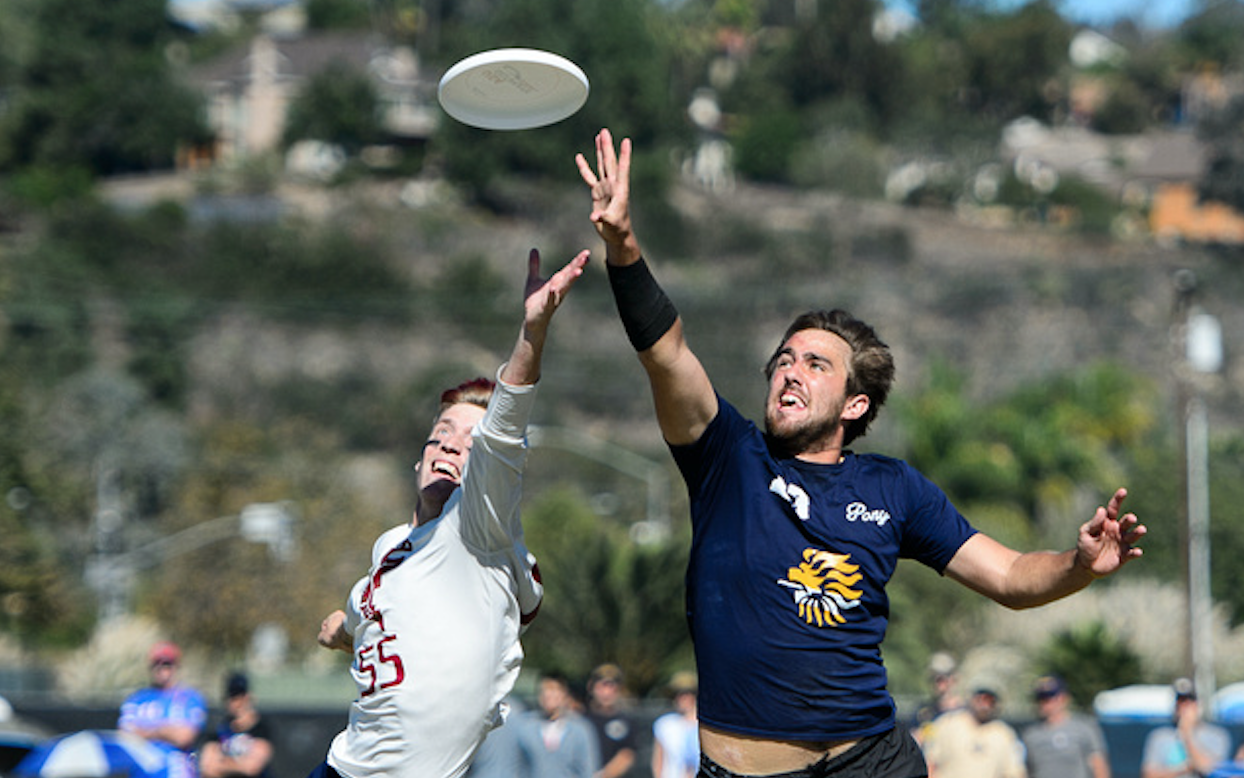
Ultiworld’s “Decade’s Greatest” series is presented by Greatest Bag. Get the greatest bag in ultimate at GreatestBag.com!

“Who are the best players in the game?” is perhaps the most fundamental argument in the coverage of any sport. It is often fiercely debated and is as much a conversation about the definition of “best” as it is about who should be in consideration.
As part of our Decade’s Greatest series, we set out to figure out who were the 10 “best” players of the 2010s — who had the biggest impact and success within the sport over the course of a decade.
We considered success in any and all competitions, from college to club to international play and looked at awards won, championships claimed, on-field performances, and the general impact on the narratives of each season. We eschewed hard metrics or point systems and instead tried to holistically debate each player’s overall resume. Earning a spot on this list required a combination of both lofty peaks and impressive longevity — spending two years at the top of the game at either the start or end of the decade wasn’t enough to be included.
Narrowing this list down to just ten names was hard enough without then parsing the particular ranked order. After plenty of internal debate, we landed on our final list1 then asked long-time teammates or opponents to help tell the stories of what makes these players so good.
Dylan Freechild
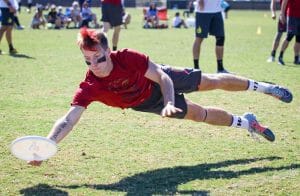
The story of Dylan Freechild’s ultimate career is the sport’s tidiest narrative arc of the decade. He fueled and then extinguished every question about whether he could win when it counted, about whether his reputation outstripped his actual talent. He entered the decade as potential energy and became a kinetic storm of upline cuts and layout blocks that left him as POTY and a national champion.
So much can be said about Freechild’s style, the give-and-go breakneck offense or predatory defense, that it can overshadow his actual effectiveness. For some, style can become a hindrance when the championships aren’t there; without winners medals to accompany it, what good is style? But as the decade bore on, dismissing Freechild’s game because of a reductive “rings” mentality became untenable and at some point a consensus coalesced around his greatness. Maybe it was that block against Japan at WUGC. Maybe it was his imperious presence at the 2017 World Games. Maybe it was when he made the jump to Sockeye and ripped off three straight 1st team All-Club seasons.
By the time Freechild won his first National Championship in 2019, the only thing left to do was finally put a medal around his neck. He’s a player whose flash could blind some to his actual quality, but over the decade has definitively proven what should have been clear all along — that the flash was an emanation of the excellence burning inside him.
“He cares. A lot of people care, but Dylan lives and breathes this sport and has for every moment of the last 15 years,” says Jimmy Mickle. “There’s not a lot of days where Dylan shows up and isn’t ready to play. He is present in every game and at every practice, partly because there is nothing in the world he would rather be doing. He’s got an infectious energy, both as a teammate and as a competitor and his level of energy pushes everyone else.”
Kurt Gibson

“Cold-blooded killer.” “Fastest gun in the west.” “A physical manifestation of death, coming for other teams’ seasons.” With anyone else this is just overly stylized hyperbole, but with Kurt…
Winning three titles with three different teams, and coming one point short of making it four with four will get people talking about you like a fictional character. Other players can get sublimated by the teams they play for but Kurt always seems to just arrive at a team’s doorstep when needed, win a title, and then move on. He’s Mary Poppins, if Mary Poppins had a monster flick huck and played handler D like a wolverine.
There is just no one else in the sport who embodies this kind mythologizing, perhaps because there is no other great player from this decade who has so effectively separated their narrative from the teams around them. It’s easy to paint Kurt as a wandering ronin — roaming the countryside, dispensing cold justice on those who cross him — because of the actual nature of his career but also because our image of him isn’t wrapped up in our impression of a particular team. Beau is inextricably linked with Revolver, but Machine is as much a part of Kurt’s narrative as the other way around.
But while Kurt has a reputation as an individual, it has much less to do with his style of play and more about the results that follow. He doesn’t necessarily have a signature move or even a solidified role on the field. For some players, winning comes as a product of what they do well on the field. For Kurt, what he does on the field is dictated but what it will take to win.
“I knew very little about him but I suppose he was everything I was hoping for and then some,” recalls Josh Markette about playing alongside Kurt on Ironside during their 2016 National Championship run. “I expected him to be good at a lot of things so I guess what surprised me most was his ability to play both ways and be so clutch during prime time.”
No one, no matter how much we compare them to the Grim Reaper or Mary Poppins, can win in this sport on their own. Kurt’s value on the field is not just his defense, or his break throws, or his first step on an upline; it’s the sense of purpose and clarity he brings to a team, any team, when he steps on the field.
“Playing with Kurt during big moments at Natties that year certainly gave me a sense of calm and confidence,” said Markette. “We were a bunch of jitterbugs and I think Kurt’s presence had a very positive impact on me — and others, I assume. He led by playing so well on both sides of the disc. He was always completely focused, level-headed, and driven to win. By the end of 2016, I trusted Kurt, as a player, as much as anyone I’ve ever played with.”
If you needed to win a game, one game with everything on the line, how could you want anything else?
Ashlin Joye
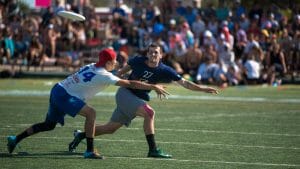
The best center handler of the decade, full stop. “An Ashlin Joye type” is what you have to say now when describing the ideal person to center the rock up to. Massive throws, liquid breaks, vicious dump cuts, and a radar map of the field in his head at all times, Joye checks all the boxes.
His CV contains the same laurels as all the other Revolver players of his era. Posture-altering collections of international and domestic medals hanging from his neck. But his legacy may have been burnished most by a title he and Revolver did not win — the 2016 season that Joye took off from playing club. As Revolver leaked four breaks to Ironside down the stretch of the title game, everything Joye brought to the offense became abundantly clear in his absence.
During the peak of his run with Revolver — that 2013-2017 stretch when he only lost a single game at Nationals — Joye had an unshakeable confidence and aura of responsibility that was reflected in the ethic of the team around him. And also, he can just flat out sling a frisbee. An all-time “the disc is an extension of his body” thrower, there is a purity to the way a disc travels from his fingertips to a receiver’s hands, even when it is rocketing out at a million miles an hour. You want to talk about grit and grace? Whammy.
But pure throwing ability isn’t what made Joye the best at what he did all decade. Unleashing a field-bending throw is just a result of all the work a great handler does getting to a spot in the dump space, reading the defense, and moving the mark
to set that moment up. And as his former teammate Grant Lindsley can attest, Joye was a master of this craft every step of the way.
“Many have appropriately called Ashlin one of the best throwers in the game,” says Lindsley, “but his true genius is his signature shimmy. If you can reliably move your mark whenever you want, you create uncontested throwing lanes. At Revolver practices, we’d sometimes run a team-wide marking drill, and even though everyone knew what was coming when Ashlin had the disc, the shimmy never failed. It’s the best shimmy I’ve ever seen.”
Beau Kittredge
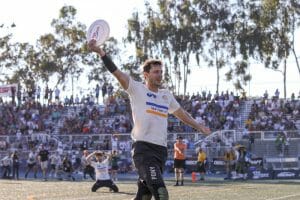
Look at the rings. Look at the highlights. He jumped over a guy in the 2000s, but he ran all over everyone in the 2010s. Revolver, unquestionably the team of the decade in the 2010s, didn’t win Nationals without Beau. No AUDL team that won a title with Beau has won one without him. There are mitigating factors here of course, but the facts are the facts. No one was a bigger trump card, no one made other teams tremble like Beau.
It’s hard to write about Beau’s game because the images of his career have become so iconic. His full frame on top of another man’s head as he vaults an entire person. A human torpedo extending for a somersault layout goal. Cutting upline against half of Sockeye’s defense at Worlds and turning Danny Karlinsky into a tiny, angry backpack. But the best illustration of his game is not in those wild highlights, but ways his size and strength would casually overcome opponents without you even seeing how.
Lou Burress described this phenomenon in his commentary on the 2012 WUGC semifinal when team USA and Beau took on Canada. Kittredge cuts deep for a backhand huck from Robbie Cahill and the disc hangs a touch by the front cone. The Canadian defender is closing for what should be an exciting aerial battle. And then he runs into a brick wall and falls away, with Kittredge calmly collecting the goal.
“Most players, when they shield position, shield it from the ground. [Beau] is so strong and such a great leaper, he shields that position in the air with his body. He’s still playing position when he’s two feet off the ground. A cagey veteran move is to hold your defender off and catch the disc without jumping. That’s essentially what Beau is doing, but his not jumping puts him 24 inches in the air; everyone else’s not jumping looks like not jumping.”
This athletic superiority is what gave Beau the tools to be great, but as his PoNY and Empire coach Bryan Jones will tell you, the athleticism isn’t the whole story.
“It’s what between the ears that truly makes Beau special,” says Jones. “Unwavering self-belief blocks out doubt when the game is on the line. It doesn’t matter if he hasn’t throw a huck all tournament, he would pull the trigger without hesitation. He didn’t just rely on his natural gifts, but is a detailed observer, seeing tendencies that others aren’t looking for. Most impressively, there were times when he could simply ignore injuries, pretending as if they didn’t happen…. You’d be hard-pressed to find someone who was more determined and present.”
Mark Lloyd
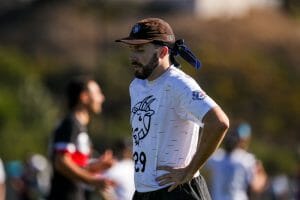
“When Mark is on your team, you feel like you have a chance to win,” says fellow Canadian legend Morgan Hibbert of Lloyd.
That feeling can go a long way. Faced with a decade of staring up at the Revolvers and Ironsides of the club division, and the American juggernauts in international play, the volcanic potential of Mark Lloyd’s game always gave his teams a chance when it seemed like there should be none.
There is far more to Mark Lloyd’s career than one game against Revolver in 2014. But you have to start there at least. It was perhaps the best single-game performance of the decade, taking down the World Champs in the middle of their dynasty. The only time from 2010-2018 that Revolver didn’t make the finals at Nationals was the afternoon when Mark Lloyd gave them both barrels.
As Hibbert puts it, “That was when Mark went full MJ. The way he played in that game just filled the entire team with the belief that we actually could knock off the giant. He quite literally put the team on his back and would not let us lose.”
Beyond his peak in 2014, Lloyd put together an unassailable resume as the best Canadian player of the decade. Two-time First Team All-Club. AUDL champion in 2013. Centerpiece of Team Canada at virtually every major international competition. And more than what he did on paper, his play inspired a generation of players from his home country. He became the face of a national team with one of the proudest histories in the sport.
“There are many kids now across the country who started ultimate by watching Mark Lloyd highlights and that has inspired them to pursue a journey in ultimate,” said Hibbert. “He shows a way for the growing future generation of ultimate frisbee stars in Canada to follow and emulate. He really exudes the best of what Canadian ultimate has to offer.”
Jimmy Mickle
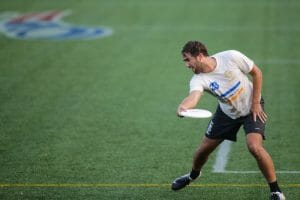
The idea of “dual-threat” offensive talents was the go-to framework for ultimate commentators over the decade. Seemingly anyone who could a) throw and b) catch was qualified for the moniker, and it became the dominant way talent was evaluated. It fails to fully capture the value of a player — Beau was the best player in the world when he could barely throw — but when you watch Jimmy Mickle play, you get why assessing player quality through this lens is so attractive. He can put a disc on a platter 70 yards away and he can jump over you to catch one. Boiled down to its simplest essence, this is how you threaten defenses on an ultimate field.
But massive hucks and skies are not the totality of offense, and notably, they aren’t the totality of Mickle’s game. Mickle may have recast the mold for what a “dual threat” looks like in the decade, but by his masterpiece season in 2018 he was operating with far more nuance. Watch him grind past Ring of Fire at WUCCs with shifty handler cuts, or tear open Revolver’s endzone defense with backhand pivot flicks, and you realize that he is a singularly threatening figure on the ultimate field.
“When you watch Jimmy’s throws at WUCC 2018 or with PoNY that season — he has a precision to the edge of every throw, precision to every breakmark movement, and precision to every jab step to get open in the reset space,” says Mickle’s former coach Bob Krier. “And if you watch the 2018 WUCC quarters against Ring, Jimmy had an 80+ yard upwind backhand that only he was capable of doing.”
Power and precision, all wrapped into one unstoppable offensive force, is the legacy Mickle leaves on the decade. He wasn’t this complete package all decade long, and his game was tweaked by a whole generation of top US coaches before he reached the absolute summit in 2018, but his abilities were so evident all decade that no one who saw him play would have been surprised to find him here at the end.
“It’s like when you see a puppy, and the puppy has huge paws,” said Krier. “ You know that the dog is going to grow into the size of the paws, and is going to be a big dog.”
Cassidy Rasmussen
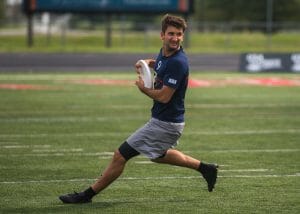
“[With] lots of players you could be like, ‘Okay, I’ll pick my poison’ but with Cass, even with the poison you picked, you were dead. You were just not gonna have a great time.”
That’s Lucas Dallman, one of the world’s best defenders explaining why Cassidy Rasmussen has been such a nightmare to compete against over the course of his career. He’s lethal all over. In his time on San Fransisco Revolver, he has played in every role of the positional Punnett square — offensive handler/offensive cutter/defensive handler/defensive cutter — and excelled in every one.
Rasmussen’s success is both a testament to his individual achievement, and is emblematic of Revolver’s dominance this decade as a whole. Winning titles as a role player on the early 2010s Revolver teams, he upgraded his game as the decade went on and became one of the San Francisco club’s crown jewels, winning POTY in 2015 while leading Revolver to their fourth title in six years.
He was a key acquisition on the 2016 Roughnecks black hole of AUDL talent, then went back to the Bay in 2017 to win another title and posted a nasty 60A/35G/14B season. That impressively rounded stat line is emblematic of the complete player that he had become. As Dallman puts it, “We know if we put him on a particular person we ostensibly erase that person, which is always just great to have. Whatever the rock, paper, scissors equivalent is, Cass is just dynamite or fire. We always had that. And then on offense on a turn, he was just so smart. He knew he could do whatever he wanted.”
Not to be ignored is Cassidy’s last season of the decade, where he earned All-Club honors as one of the key holdover pieces keeping Revolver together and competitive after the exodus following the 2018 season. Rasmussen’s trophy case certainly wouldn’t be as full if he weren’t part of Revolver’s system, but he has proved to be more than just a byproduct of the team’s greatness and has been crucial in keeping the program churning into the 2020s.
Matt Rehder

One of only two players on this list who was rostered on the same club team every year for the entire decade. That kind of consistency is the way to look at Rehder’s career, not because of who he was playing for but because of the consistently excellent production every single year.
Rehder may be the player whose legacy would be the most improved by the availability of more sophisticated statistical metrics. Just looking at the raw yardage totals from 2019 Nationals give us a glimpse of what kind of statistical monster Rehder has been over the past ten years. Between the yards he gobbled up on deep cuts, the free unders terrified defenses gave him, and the long-range bombs he slung deep, it seems entirely plausible that he has led the men’s club division in total yardage for the decade.
A big part of what allowed Rehder to pile up such consistent production over the entirety of the 2010s is how bafflingly young he was when he started playing elite club. Sockeye first rostered him in 2008 as a 16-year-old, and it proved to be one of the all-time great youth investments in the history of the sport.
“The moment I knew Matt was special was his first tournament with Sockeye, at Cal States in Santa Cruz in 2008,” says Sockeye coach Mike Caldwell. “He was just 16 years old and already a very gangly 6’3″. We were still in tryouts, and he was a long shot to make the team simply because of his age, but he showed such upside that we’d kept him around, even though we weren’t sure what to do with him.”
Rehder has repaid that faith many times over since then, as an invaluable piece in Sockeye’s finals runs in 2013 and 2015 and culminating in Seattle’s 2019 championship. They figured out what to do with him, and he’s been doing it at the highest level ever since.
George Stubbs
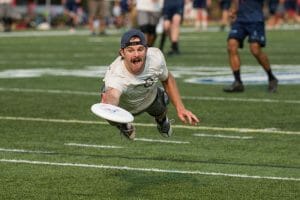
The oldest of the wildly successful Stubbs siblings — who were likely the most dominant ultimate family of the 2010s — George is the only one of the trio to win a Callahan, a National title, and make a World Games roster (he made the roster twice, in fact). Stubbs was a terror in the early half of the decade on those doomed Ironside teams that went to three finals in five years, then captained that monster 2017 Revolver team to his first National championship.
Stubbs has all of the speed and skill needed to back up his reputation, but that lightning first step and flick huck aren’t what got him on this list. Ask any one of his former teammates, and they’ll say the same thing: George Stubbs is one of the best leaders in the history of the sport.
“A lot of folks can attest to George’s skills on the field. Anyone can watch film and see what a well-rounded and versatile player he is — traits that are especially critical in a National Team setting. But what makes George so great as an ultimate player, and what makes him so special to me, has nothing to do with athleticism or skills, but rather with who he is as a person.”
That is Stubbs’ teammate from the 2013 and 2017 World Games squads, Sarah Griffith.
“George has a maturity about him and a way of making people feel seen and appreciated as whole humans. The 2013 World Games team was one of the most special ultimate experiences of my life, not because of our team’s talent, but because of the way experienced players like George, Chase Sparling-Beckley, Ryan Farrell, and Cara Crouch committed their whole hearts to making us a team. George looks out for you, he listens to you, he loves you, and he brings everyone in.”
Stubbs may have never been Club POTY or the best player on a championship team. He was never quite the same on the field after his 2015 hiatus, and won his lone title as part of an overwhelmingly talented Revolver team. But there is a reason he’s one of only two male players to feature on both World Games teams this decade — and being selected captain by his teammates both times. There is a reason he was captaining that Revolver team in only his second year in the Bay. When he is at the helm, everyone gets better.
Mac Taylor
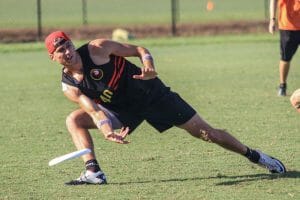
One of the most popular personnel moves this decade was to exploit the big guy in small spaces. Whether it was Pitt running Tyler Degirolamo bully ball through their endzone set or Nathan White clamping down on handlers with his rubber limbs, in the 2010s the backfield was not just for squirrely handlers. One of the key prototypes for this was Mac Taylor, a human blueprint for huge length with feet quick enough to guard handlers and then abuse them off the turn.
“I think many people would first think of Mac as an offensive powerhouse who teams mostly just tried to contain and hope to minimize his contributions,” said Alex Synder, another legend of Bay Area ultimate. “But Mac was dominant on both sides of the disc. At the World Games in 2013, he was often assigned the toughest match-ups with any opponent and consistently took them out of the game. His athleticism on defense got us the disc, his talent on offense made sure his efforts didn’t go to waste.”
Taylor had the ability to collapse the gap between roles on the field and just be an asset — perhaps the most valuable asset in the game during his peak. He was a terrifying force helping Revolver to their first two championships in 2010 and 2011, then jumped to the mixed division for the middle and later thirds of the decade where he pulled down OPOTY and multiple 1st team All-Club honors with Blackbird.
While he may not be a top 10 player at this point in his career, he was so tremendous during the first few years of the decade that he warrants inclusion on this list. Even on the downslope of his career he still won gold at WUGC in 2016 and an AUDL title in 2017. He’s one of the most important players in the evolution of how the game was played, and always one of the most important on the field as well.
Presented below alphabetically. ↩